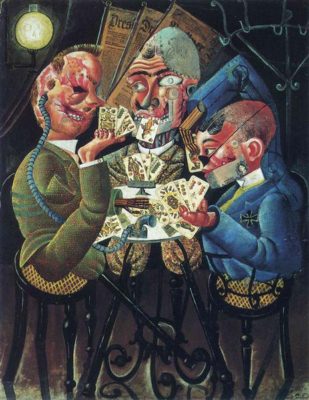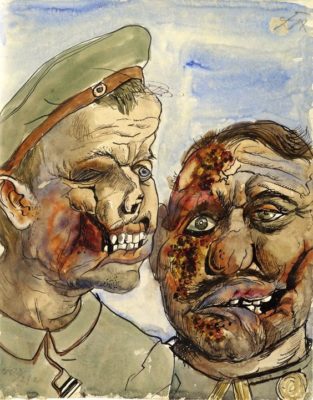I have just returned from two nights in Paris where I visited a museum exhibition about Africa, saw paintings, and was reminded of Otto Dix’s war paintings — and his paintings of war injuries in particular.
We travelled there by train, which gave me many lovely hours of dozily dreaming and reading. It was a foggy, misty day so staring out at the landscape provided only patchy views of the landscape.
African artists and Trade
From the Gare de Montparnasse we rushed to the fantastic Musée du Quai Branly-Jacques Chirac.
I wanted to see ‘L’Afrique des Routes’, an exhibition that turns European perspectives about the African continent upside-down.
All humans originate from Sub-Saharan Africa. From Africa, humans have spread around the world. We are all one people, one humankind.
Africans were the first travellers, explorers, traders, adventurers and artists in our world and this exhibition is about that trade and those routes.
Otto Dix’s War Paintings and The Tin Heart Gold Mine
To my surprise, however, I was abruptly reminded of my new novel The Tin Heart Gold Mine and the connection between European wars and Africa.
In the last room of the exhibition, the museum put together damaged African masks juxtaposed with photos of WW1 soldiers whose faces had been blown off by shrapnel. These terrible facial injuries were very common in trench warfare and something that Otto Dix witnessed as a soldier and then painted.
One theme of The Tin Heart Gold Mine is war-damaged people, which is why I decided Otto Dix’s war paintings must inevitably be part of the art collection of Lara’s lover, Oscar.
Musée du Quai Branly-Jacques Chirac
This was a small part of the wonderful Quai Branly exhibition and it’s not a big part of my book. The photos and paintings are distressing, so there is no need to follow the Otto Dix links I have provided, though historians may find them interesting.
There is also a novel by Pierre Lemaitre called Au Revoir La-Haut about survivors of these injuries and it has been made into a haunting comic book or bande dessinée.
Exciting News: The Tin Heart Gold Mine official book launch
Since my return from Paris, I have been occupied with preparing for the The Tin Heart Gold Mine official book launch, to be held at the Café du Centre, Maubourguet, at 19:00 on 24th March 2017.
The invitation went out on Friday 3rd March (yesterday). If you want to be there, but haven’t received an email, please click [RSVP to Book Launch] to email me so I know you are coming.
RSVP to Book Launch2 Otto Dix, In Memory of the Glorious Time, 1924


4 Comments on “Paris, Africa and Otto Dix’s war paintings”
We seem to live in a world of damaged people and it is hard to know what would ever help. Being meditative and creative like you must be very good.
Lorraine I do think that we all have to be creative to cope with the world and the damage as we find it – I think you have always done that too creatively.
The world has always been populated by damaged individuals, it is only the current obsession with beauty and perfection that highlights physical and more recently emotional damage. Art has always provided a focus for the expression of damage, Siegfried Sassoon and his poetry for instance, but there are many who neither understand or have access to art. I don’t have an artistic cell in my body, but have seen first hand emotional and physical damage and so prefer to see what I think is the real world and therefore devoted my life/time on this earth to practical support. It is only in my latter years I have begun to understand some art, (I don’t think I will ever understand Tracy Emmin) much remains an anathema to me. Give me an operating theatre and tools to mend any day. I prefer your later blogs as you provide more of an insight into humanity. For me you need to explain not just state, or are you simply pointing the way for furhter exploration for example of the work by Otto Dix, or even Otto himself?
Thank you for your heartfelt comment, Chrissie. I guess I wanted to leave open my post so that other people can react in their own way to Otto Dix and the damage done by war to survivors. Also, as the paintings come into the story, I didn’t want to say too much about them until I know what readers think of their significance in the plot.